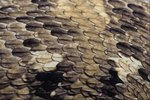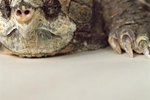
Southwestern Louisiana is synonymous with Cajun country, the home of the French-Canadian exiles known as Acadians. Lafayette and Lake Charles are among the largest cities in the five parishes making up southwestern Louisiana. Various species of nonpoisonous snakes also dwell there, in habitats that vary from bayous and swamps to dry prairies.
Dry Land Snakes
The eastern hog-nosed snake (Heterodon platirhinos) is about 3.5 feet long, with grayish-tan or dark brown coloring and rows of black spots on its sides and back. Preferred habitats include dry or wooded country, although the eastern hog-nosed snake is found throughout Louisiana excluding swamps. The coachwhip (Coluber flagellum) might grow as long as 7.5 feet and can be solid black or have a brown body growing darker near the tail. Because they bite hard if cornered or captured, they have a false reputation for being venomous. Coachwhips inhabit the pinewoods near Lake Charles.
The colorful, black-, red- and white-ringed milk snake (Lampropeltis triangulum) grows to about 2.5 feet and dwells in mixed pine and hardwood forests -- a habitat it shares with the racer (Coluber constrictor), a white-throated black snake maturing at 5 feet. The western ribbon snake (Thamnophis proximus) grows to about 3.5 feet. This thin black or brown snake has a yellowish stripe down the back and a light stripe on each side. It likes sunny areas, such as pastureland.
Water Snakes
The diamond-backed water snake (Nerodia rhombifer) is found throughout the state in marshy areas. Reaching 5 feet or longer, its gray or tan body boasts dark crossbars on the sides and back, and a yellow underbelly. The banded water snake (Nerodia fasciata) can reach over 4 feet in length and prefers swamp-living. This dark-colored snake has yellow-orange crossbands and light orange bands around the eye. The Mississippi green water snake (Nerodia cyclopion) might be greenish, olive or brown, with dark squares along the back and sides. Found in marshes and lakes, it can grow over 4 feet long.
The yellow-bellied water snake (Nerodia erythrogaster), dark green or gray with large blotches and a light belly, matures to 4.5 feet. It lives in both watery and wooded areas. The mud snake (Farancia abacura) can reach nearly 7 feet. Black with a red belly and black bands, it's found in swamps throughout Louisiana. The prairie kingsnake (Lampropeltis calligaster) is over 4 feet in length and favors cropland and pastures. It's gray-brown with red blotches. The salt-marsh snake (Nerodia clarkii) grows to about 3 feet and dwells in southwestern coastal marshes. It's gray with three dark stripes.
Backyard Snakes
According to the state Department of Wildlife and Fisheries, the small brown snake (Storeria dekayi), which doesn't exceed 16 inches, is the most common snake in urban and suburban Louisiana. Found throughout the state, the snake's brown body might have rows of black dots on its sides. The much larger common garter snake (Thamnophis sirtalis) can mature at nearly 4 feet long. Their brown bodies have a lighter-colored stripe down the back and sides. The speckled kingsnake (Lampropeltis getula) grows to nearly 5 feet and is black with white speckles on each scale. It can be found in wooded areas near habitation. If you live on a farm, you might welcome the presence of the western rat snake (Pantherophis obsoleta) because he's named for his main food source. Growing to 7 feet long, this gray snake has tan or dark blotches.
Crayfish Snakes
What kind of snake could be more at home in the Pelican State's bayous and swamps than crayfish varieties? The dark, glossy crayfish snake (Regina rigida) spends its days in crawfish burrows and hunts at night. It matures at about 2.5 feet. Graham's crayfish snake (Regina grahamii) is under 4 feet. Olive or gray-bodied, it has a yellow underbelly and a tan line down the back.
References
Photo Credits
-
Jupiterimages/Photos.com/Getty Images
Writer Bio
Jane Meggitt has been a writer for more than 20 years. In addition to reporting for a major newspaper chain, she has been published in "Horse News," "Suburban Classic," "Hoof Beats," "Equine Journal" and other publications. She has a Bachelor of Arts in English from New York University and an Associate of Arts from the American Academy of Dramatics Arts, New York City.




